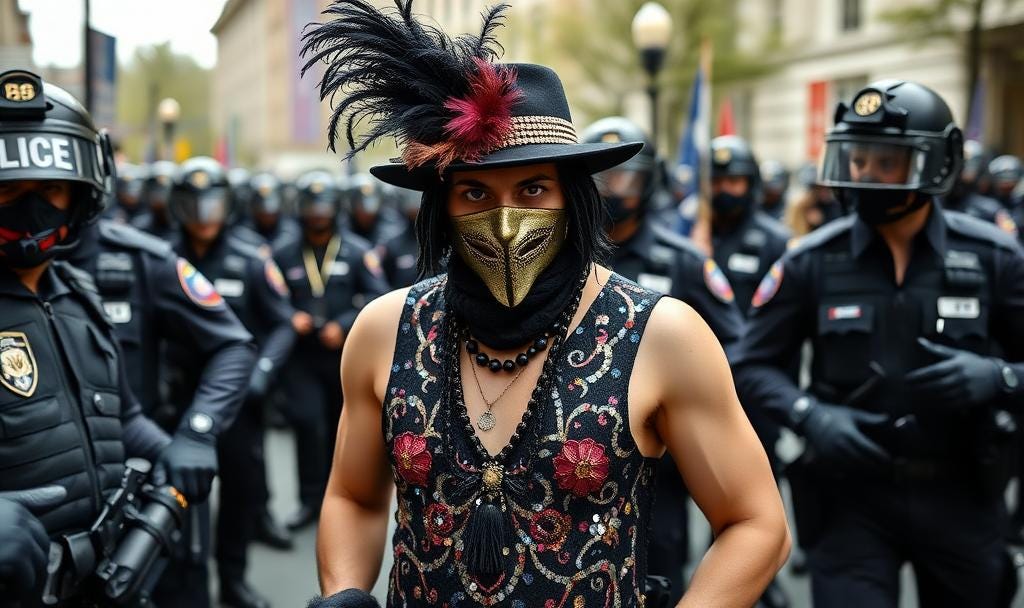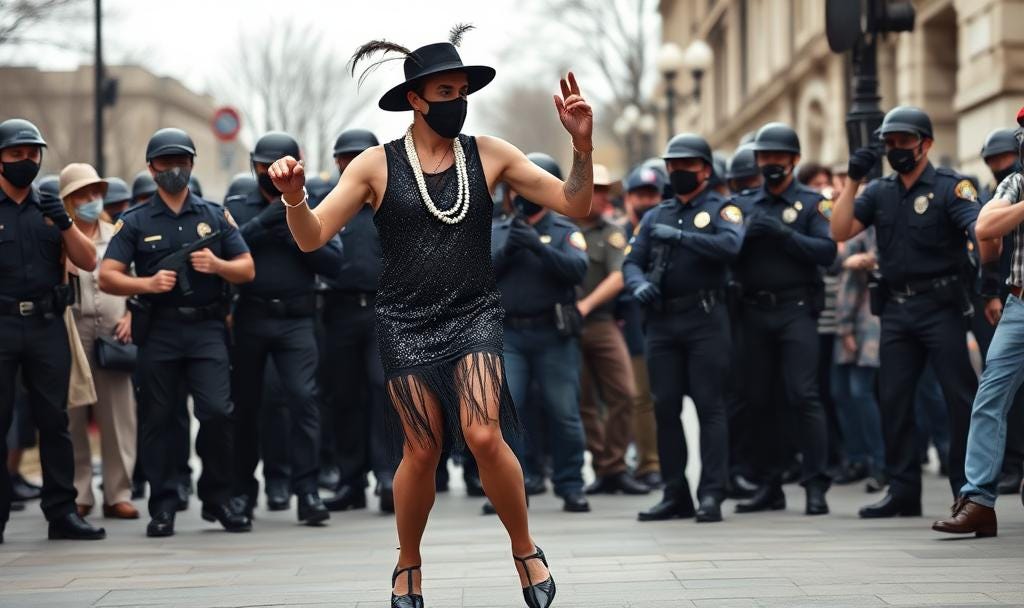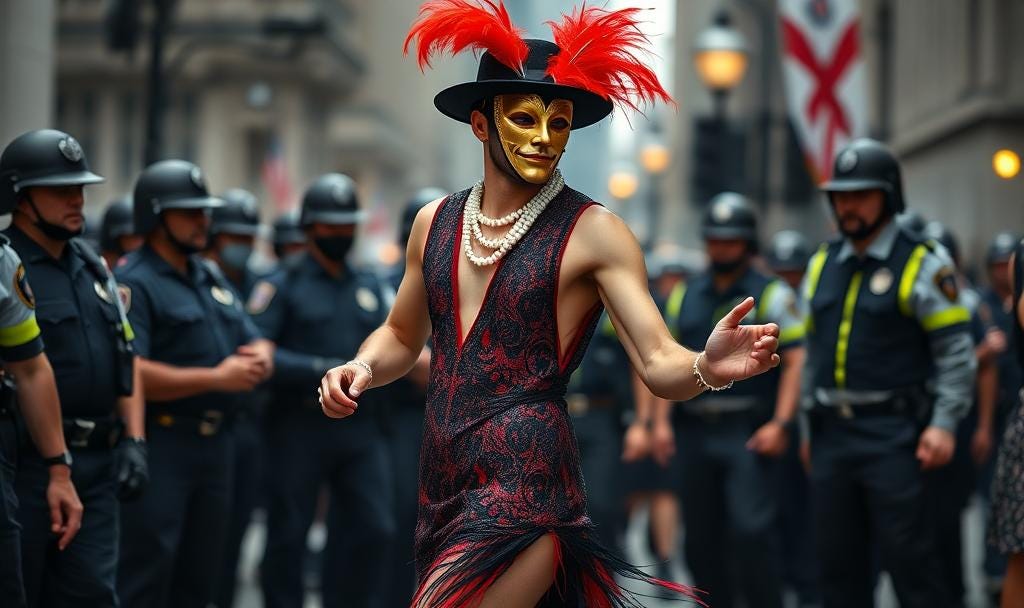Antifa Unveils Dazzling 1920s Flapper-Inspired Makeover
Antifa's Flapper Revolution: A Fashionable Fight Against Fascism
In a surprising twist on political aesthetics that has left political commentators scratching their heads and fashion critics reaching for their smelling salts, the traditionally black-clad antifascist movement has undergone what can only be described as the most dramatic sartorial transformation since punk rock discovered safety pins.
Antifa has reportedly unveiled a bold new look inspired by the glitz and glamour of 1920s flapper fashion. This unexpected makeover has sparked conversation across social media and among cultural commentators, blending radical activism with the iconic style of the Roaring Twenties.
A Fusion of Activism and Art Deco
The new Antifa look draws heavily from the flapper era, known for its rebellious spirit and break from traditional norms—qualities that resonate with Antifa’s own ethos. Members have been spotted donning beaded dresses, feathered headbands, and art deco accessories, all in the classic black and red color scheme associated with the movement.
The decision was also part of a greater strategy to rebrand Antifa as more fun-loving and stylish.
“Black bloc chic is so late 1990s,” said an anonymous Antifa member. “We wanted to give the message that not only were we tough on fascists, but we also knew how to have a good time. Recruitment was down, because, let’s face it, Gen Z is a bunch of lazy-ass pansies.”
After a pause, he also added, “I’m also digging 1920s slang. It’s the cat’s pajamas! It’s also useful. When it’s time to scramble after the pigs show up…23 skidoo!”
Antifa unveiled their new look at their latest attack on a Portland federal building, leaving law enforcement officers stunned and bewildered.
The new look, labeled “Antiflapper,” was designed by the famous nonbinary nonspecies Seattle fashion maven known only as “Glammm.”
“Darling, fascism is so last season. I wanted to give Antifa a look that says, ‘We’re here to dismantle oppressive systems, but also to slay.’” Glamm said in its Seattle home, a large hollowed-out rock. “Sequins are the new black, and whips disguised as necklaces? That’s just good design.”
Glamm also explained: “I wanted to give Antifa the power to blind oppression—not just with their ideals, but with the sheer radiance of their rhinestones. If you can’t outmaneuver the police, at least outshine them!”
From Militant Monochrome to Jazz Age Glamour
The 1920s flapper was a symbol of liberation, challenging gender roles and societal expectations. By adopting this style, Antifa says it is making a statement about the ongoing struggle for freedom and equality. The juxtaposition of vintage glamour with modern activism highlights the timeless nature of resistance.
“We’re proud to be Antiflappers,” said one sequined-faced activist. “We thought about calling the new style ‘Antifapper,’ but, despite stereotypes, we aren’t dominated by incels. Believe it or not, most Antifa have pretty good sex lives. Women love bad boys.”
The move was driven in part to modernize the Antifa movement and show it was not just about strong tactics, but kickin’ style.
The Classic Black Bloc Aesthetic
For decades, the antifa uniform was as predictable as it was practical:
All-black everything: Hoodies, jeans, boots, and bandanas
Functional accessories: Backpacks for supplies, sturdy footwear for quick escapes, black umbrellas
Anonymity-focused: Face coverings and nondescript clothing
The Flapper Revolution
But the new Antiflapper has brought an unprecedented shift toward 1920s glamour:
Dropped waistlines replacing tactical vests
T-bar shoes instead of combat boots
Feathered costume masks as the new face covering of choice
Pearl necklaces worn as symbols of rebellion against capitalism - which can also double as whips and choke wire as necessary
The Practical Challenges: Protest Logistics in Vintage Wear
The transition to vintage wear at recent protests has not been without its complications. Protesters have found themselves mastering the art of a strategic retreat while running in Mary Janes, a skill that requires agility and forethought, particular when navigating concrete rubble thrown at cops.
Managing fringe and other decorative elements on their outfits has also proven challenging, as they can be easily set aflame when throwing fireworks and molotov cocktails. Weather conditions add another layer of difficulty, with many wondering how to maintain carefully styled finger waves when faced with tear gas and other environmental hazards.
Meanwhile, internal discussions among organizers have become lively as they debate the effectiveness of using cigarette holders to throw firecrackers. Some have even explored the revolutionary potential of incorporating the Charleston dance as a technique for fighting back at police.
Public Reaction
Reactions to the makeover have been mixed. Supporters praise the creativity and historical nod, seeing it as a clever way to draw attention to their cause. Critics, however, question whether the glitzy aesthetic distracts from the movement’s core messages.
Some criticism has not been kind. Radical feminists called the new move another form of “Ladyface” and said that Antifa men were co-opting women’s identities.
“Women’s identities are not costumes,” said Felicia Tart, leader of a new girl band. “But I must admit, Antifa is rocking it with the Charleston. I don’t know what it is, but feminists just can’t dance.”
The Power of Visual Identity
This dazzling transformation underscores the importance of visual identity in political movements. By embracing a look that is both nostalgic and subversive, Antifa continues to challenge expectations—not just through protest, but through fashion as well.
Now fashion insiders are now bracing for the next big thing: Victorian Anarchists, whose weaponized corsets will reportedly cinch not only waists but also centuries of structural oppression.
Meanwhile, Medieval Militants are dusting off chainmail for everyday wear, insisting it’s not just for protection against office politics but also a bold political statement—finally giving “suit of armor” new meaning at Monday meetings.
And just when you thought things couldn’t get stranger, Futuristic Freedom Fighters are storming runways in cyberpunk gear, blending LED-lit balaclavas with direct action—because nothing says “revolution” like a neon mohawk and WiFi-enabled combat boots. Fashion, as always, remains two steps ahead—and possibly off the deep end.
Whether this flapper-inspired makeover is a fleeting trend or a lasting shift remains to be seen. What’s clear is that Antifa’s new style has reignited conversations about the intersection of fashion, history, and activism, proving that sometimes, resistance can come with a touch of sparkle.
Disclaimer: This piece is entirely satirical. No actual antifa fashion revolution has occurred, and any resemblance to real sartorial political movements is purely coincidental.











🤣
The style is missing Palestinian scarfs somewhere, if all credit points are to be scored. :>)